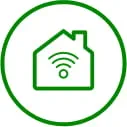When it comes to choosing an internet service, it’s sort of like picking a mode of transportation. Do you want a horse and buggy (DSL), or are you ready for a rocket ship (fiber)? We know that might sound a little overdramatic, but the differences between DSL and fiber internet are pretty stark — and once you know them, you’ll see why fiber is pulling ahead in this race faster than a hamster after a double espresso. So, buckle up as we explore the key differences between DSL and fiber internet.
What is DSL?
DSL, or Digital Subscriber Line, has been around since the 1990s. It works by transmitting data over copper telephone lines. And while DSL has served us well over the years it has its limits. The speed and reliability of DSL depend heavily on how close you are to the service provider’s central office. The further away you are, the slower your internet will be. Think of DSL as a trusty, old car: it’ll get you to where you’re going, but you never know how long it’s going to take.
What is fiber internet?
Instead of copper, fiber-optic cables use light to transmit data, which means your data travels at, well, the speed of light. These cables are made of super-thin strands of glass or plastic (we’re talking thin as a human hair), and they’re bundled together to create a kind of superhighway for your data—and here’s the best part—there are no speed limits. Fiber doesn’t care how far away you are or how many of your neighbors are streaming movies; it’s designed to handle the traffic without even breaking a sweat.
The key differences between DSL and fiber internet
Speed and bandwidth
- DSL: Speeds generally range from 1 Mbps to 100 Mbps, depending on the plan and how close you are to the central office. DSL can be sufficient for basic web browsing, checking emails, etc, but if you start adding more devices or trying to stream in HD or 4K, you’re going to experience lag or buffering.
- Fiber: Fiber offers speeds up to 1 Gbps (1,000 Mbps) or more, making it ideal for heavy internet use. This means you can download large files in seconds, stream ultra-high-definition videos without buffering and have multiple devices online simultaneously without any slowdowns.
Reliability
- DSL: DSL connections can be quite sensitive to environmental factors. Your connection can suffer from slowdowns or dropouts due to bad weather, electrical interference or simply because you’re too far from the central office.
- Fiber: Fiber optic cables, in contrast, are built to resist many of these common issues. They’re not affected by electrical interference or most weather conditions. Distance from the central point also doesn’t affect fiber, meaning you get a consistent connection no matter where you are.
Latency
- DSL: Latency can be a significant issue with DSL connections. Latency is the time it takes for data to travel from its source to its destination, and with DSL, you might notice delays that make online gaming, video conferencing or streaming in 4K very frustrating.
- Fiber: Fiber has incredibly low latency, which means your data travels back and forth almost instantly. This makes fiber ideal for activities that require real-time data transmission, like video calls, online gaming and virtual reality applications. If you want a near-instantaneous response when you click, fiber is the technology you’re looking for.
Availability and coverage
- DSL: DSL has been around for decades and uses existing telephone lines, which makes it widely available, even in many rural and remote areas. However, its age also means it’s limited by its older infrastructure, and newer technologies are beginning to outpace it.
- Fiber: While fiber internet is primarily available in urban and suburban areas right now, it’s expanding rapidly into more rural areas. Even if fiber hasn’t reached your area yet, it’s only a matter of time before it does.
Scalability and futureproofing
- DSL: As an older technology, DSL is pretty much at its maximum potential. The infrastructure (those copper telephone lines) just isn’t built to handle the ever-increasing demands of modern internet use. There won’t be any groundbreaking improvements or significant increases in speed coming for DSL.
- Fiber: Fiber is designed with the future in mind. The same fiber optic cables that deliver ultra-fast internet speeds today are capable of handling even more data as technology evolves. Investing in fiber is like buying a ticket to future-proof your internet experience, ensuring it can keep up with whatever new demands come your way.
In the battle of DSL vs. fiber, fiber internet is the clear winner. It’s faster, more reliable and future-proofed for all your needs — from work to play and everything in between. Contact Ziply Fiber today to see if we’re available in your area and get ready to experience the fiber internet difference.






